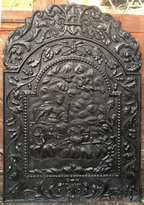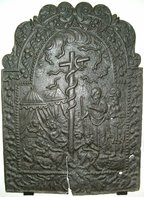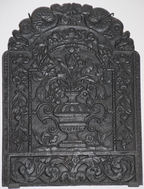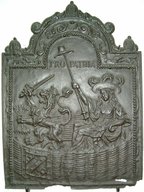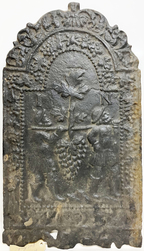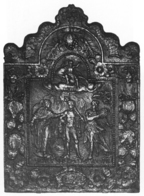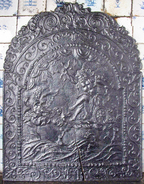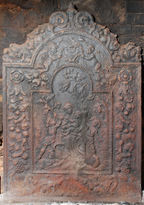-
1059
Description: Arched rectangular central panel with bead on broad fillet edging; pictorial scene of a figure in a chariot on left, drawn across clouds by two peacocks; above, a putto and a bird flying in clouds; to the right, a tree; arched rectangular border with fillet edging; symmetrical undulating oak fronds descending from a loop; at the bottom, the letter W in a cartouche between swirled foliage; on top, mirrored swirled foliage descending from a loop.
Notes: The figure is likely to be that of Hera/Juno, who is traditionally associated with peacocks. The initial 'W' probably identifies the pattern maker; a single vertical line right of centre indicates the join between two boards that formed the pattern. The 'W' initial probably denotes the pattern maker.
Inscription: W
- Decoration tags:
- 'Dutch' (shape)
- fillet (edging)
- whole carved pattern
- planklines
- pictorial
- allegorical
- text
- humans
- plants
- objects
Manufactured: in the late-17th to early-18th century in England.
Current location: not known.
- Attached to series:
- British 'Dutch' style firebacks
- W series
-
1264
Description: Arched rectangular central panel with bead edging (top and sides) enclosing a shield, helm, crest, mantling and motto of the Fitch family, descendants of Edwin Frederick Fitch (1839-1916); above the achievement, symmetrical laurel leaves, all within an arched rectangular astragal border surmounted by, on the dexter side, a behelmeted merman holding a scimitar and, on the sinister side, a mermaid holding a mirror; top centre, three ostrich feathers gathered with a ribbon.
Notes: A pastiche of the 17th century Carolean 'Dutch' series (e.g. no. 280). Blazon: Vert, on a chevron between three leopards' faces or langued gules, as many cross crosslets fitchee of the last, in the chief point an ermine spot of the second; Crest: Upon a wreath of the colours, a leopard's face erminois pierced through the mouth with a sword broken in the middle argent, pommel and hilt or.
Inscription: FACTA NON VERBA [Actions not words]
Arms: Fitch
Manufactured: in the early- to mid-20th century in England.
Current location: not known.
- Attached to series:
- Personal armorial firebacks
-
726
Description: Arched rectangular central panel with bead-on-fillet edging; pictorisl scene of a central cross-shaped pillar entwined with a snake; two pavilions to the left with human figures lying before them; two standing figures to the right, one holding a staff; above, clouds with snakes descending from the sky; arched rectangular border with fillet edging; on each side, descending festoons of fruit entwined with ribbon; at the bottom, a central cartouche between palm fronds; on top, foliate swirls.
Notes: The scene is an illustration of the plague of serpents visited upon the children of Israel by God (Numbers 21: 6).
Copies of this fireback are known.
Manufactured: in the mid-17th century possibly in the Siegerland area of Germany.
Current location: Victoria & Albert Museum, Cromwell Road, Kensington & Chelsea, Greater London, England.
Museum number: 291-1893 (part of the Victoria & Albert Museum museum group)
Citation: Anon., 2 Dec 1905, 'Old Kent and Sussex Fire-backs', Country Life, pp. 767-768.
- Attached to series:
- 'Dutch' Miscellaneous Firebacks
- Old Testament & Apocrypha firebacks
-
755
Description: Arched rectangular central panel with bead-and-pellet edging; on a ground between two plants, a fluted flower vase with two, scrolled handles, tulips and other flowers issuing from the narrow neck; arched rectangular border with fillet edging; mirrored descending flower swags; along a rectangular bottom panel with fillet edging a symmetrical arrangement of swirled foliage; narrow, curved shouldered side panels with beads in oval depressions; on top, two mirrored sea serpents.
Notes: The presence of tulips suggest a Dutch origin for the pattern of this fireback, although the presence of several examples in England suggest that it was produced here rather than on the Continent; this is the smaller of two versions of this fireback.
Copies of this fireback are known.
- Decoration tags:
- 'Dutch' (shape)
- fillet (edging)
- whole carved pattern
- extension panels
- pictorial
- plants
- objects
Manufactured: in the late-17th century in England.
Current location: Victoria & Albert Museum, Cromwell Road, Kensington & Chelsea, Greater London, England.
Museum number: 41.1896 (part of the Victoria & Albert Museum museum group)
- Attached to series:
- British 'Dutch' style firebacks
- Flower Vase 'Dutch' types
-
760
Description: Arched rectangular central panel; bead-on-fillet edging; wickerwork Garden of Holland (Hollandse Tuin) within which is seated a berobed female figure holding a cap of freedom on the end of a long pole; before her is the crowned heraldic lion of the States General of the Netherlands, clutching a sheaf of arrows in its left front paw; above are the words, Pro Patria; arched rectangular boreder with fillet edging, and foliage draped from the top; on top, a pomegranate to which ascends a serpent on each side, with a further pomegranate on each shoulder of the plate.
Notes: An overtly patriotic theme with symbols of Dutch nationhood.
Copies of this fireback are known.
Inscription: PRO PATRIA
- Decoration tags:
- 'Dutch' (shape)
- cavetto (edging)
- whole carved pattern
- pictorial
- allegorical
- text
- humans
Manufactured: in the mid- to late-17th century in the Siegerland area of Germany.
Current location: Victoria & Albert Museum, Cromwell Road, Kensington & Chelsea, Greater London, England.
Museum number: M.1411-1926 (part of the Victoria & Albert Museum museum group)
- Attached to series:
- 'Dutch' Miscellaneous Firebacks
- 'Dutch' Garden of Holland firebacks
-
1274
Description: Arched rectangular central panel with bead edging; image of two helmeted men in 17th century dress, on a ground, carrying a huge bunch of grapes slung from a pole between them, behind are vine leaves; the initials located below the top corners; arched rectangular border, fillet edging, containing vine leaves and grapes; above, symmetrical swirling foliage descending from a scallop shell; bottom of the image obscured by corrosion damage.
Notes: The scene, drawn from the Old Testament, represents Joshua and Caleb carrying the bunch of grapes from the valley of Eshcol in the land of Canaan, back to Moses and the children of Israel (Numbers 13: 23-4); a popular subject on a variety of media in the period.
Inscription: I N
Manufactured: in the mid- to late-17th century possibly in the Siegerland area of Germany.
Current location: Victoria and Albert Museum, Cromwell Road, Kensington and Chelsea, London, England.
Museum number: M.372-1912 (part of the Victoria & Albert Museum museum group)
- Attached to series:
- Joshua and Caleb firebacks
- Old Testament & Apocrypha firebacks
-
1273
Description: Arched rectangular central panel with bead on fillet edging, pictorial scene of Hercules standing, right arm akimbo and left hand holding a club that rests on his shoulder; to his right the allegorical female figure of Virtue, clothed and resting her left hand on Hercules's right shoulder; to his left the female allegorical figure of Volupta, the pair symbolising the 'crossroads' where Hercules has to decide which path in life to take; below them the text VIRTUS HERCULES VOLUPTA; above, seated above clouds, Jupiter surveys the scene, the word IVPITER below; arched rectangular border with fillet edging, from a central bunch of grapes at the top of the arch, a ribbon on each side suspends bunches of fruit and flowers; at the bottom a central cartouche containing the inscription 'L7G', with flowers on each side;; on top are two mirrored dolphins, their tails covering a bunch of grapes.
Notes: The pictorial scene is loosely based on The Judgement of Hercules, c.1636-7, by Nicholas Poussin. The inscription at the bottom indicates the style of border; other firebacks with the same inscription have the same border; similar inscriptions (e.g. L6C and L8G) indicate different borders. Image from von den Driesch (p. 512).
Copies of this fireback are known.
Inscription: IVPITER / VIRTVS HERCVLES VOLVPTA / L7C
- Decoration tags:
- 'Dutch' (shape)
- fillet (edging)
- whole carved pattern
- pictorial
- mythological
- allegorical
- text
- humans
Manufactured: in the mid- to late-17th century in the Siegerland area of Germany.
Current location: not known.
- Attached to series:
- 'Dutch' LC/G series
-
1159
Description: Arched rectangular shaped central panel, nut-shell on fillet edging, narrow-necked vase on a ground, with flowers and pea pods issuing therefrom, a plant in a pot to each side; arched rectangular shaped border with fillet edging and descending quasi-symmetrical floral tendrils; on top, quasi-symmetrical swirled foliage; date split between bottom corners, with two looped 'W' figures between. A single plankline is evident to right of centre.
Notes: The fourth largest of six flower vase designs on a discrete series of firebacks from 1724. All incorporate the looped 'W' motif which may be intended to identify the pattern maker.
Inscription: 17 24
- Decoration tags:
- 'Dutch' (shape)
- fillet (edging)
- whole carved pattern
- planklines
- pictorial
- text
- plants
- objects
Manufactured: in 1724 in England.
Current location: not known.
- Attached to series:
- 1724 series
- British 'Dutch' style firebacks
-
300
Description: Arched rectangular shaped central panel with bead-and-pellet edging on a broad fillet; Jupiter in his chariot drawn by eagles; above are clouds, below is a landscape; arched rectangular shaped border with fillet edging, with a symmetrical scrolled wire design; the monogram, SHR, bottom centre; above is a symmetrical design of scrolled floral tendrils.
Notes: The design is derived from a personification of the planet, Jupiter, in 'Planetarum effectus et eorum in signis zodiaci', by Marten de Vos (1585). Two editions of engravings of de Vos's drawings are known, by Jan Sadeler, dated 1585, and by Gregor Fentzel in about 1650.
Copies of this fireback are known.
Inscription: SHR
- Decoration tags:
- 'Dutch' (shape)
- fillet (edging)
- whole carved pattern
- pictorial
- mythological
- monogram
- animals
- humans
- objects
Manufactured: in the late-17th to early-18th century in England.
Current location: Powis Castle, Welshpool, Powys, Wales.
Museum number: 1180886 (part of the National Trust museum group)
Citation: Dawson, C., 1903, 'Sussex Iron Work and Pottery', Sussex Archaeological Collections, 46, pp. 1-54.
Citation: Gardner, J. S., 1898, 'Iron Casting in the Weald', Archaeologia, 56, 1, pp. 133-164.
- Attached to series:
- SHR series
- British 'Dutch' style firebacks
- De Vos Planets series
-
784
Description: Arched rectangular centrel panel with bead on fillet edging; central seated female with an infant in her arms, a swan at her feet and a standing child on each side, the one to her left facing the front and holding aloft a flaming heart, its foot on a ball; the child to her right facing the back, holding aloft a branch in its left hand, all on a ground with a tree behind to the right; arched rectangular border with bead edging; fructal and floral festoons suspended on ribbons with two putti at the top and two on each side; at the bottom, a central cartouche with illegible date, between floral swags; on top, twin spirals between descending floral festoons.
Notes: The group is an allegory of Charity. A recasting.
Copies of this fireback are known.
- Decoration tags:
- 'Dutch' (shape)
- ovolo (edging)
- whole carved pattern
- pictorial
- allegorical
- humans
Manufactured: in the mid-17th century in the Siegerland area of Germany.
Current location: in private hands, West Hoathly, West Sussex, England.
- Attached to series:
- 'Dutch' HHS series
- Charity firebacks
